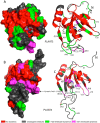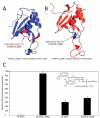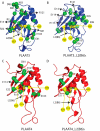Protein Dynamics Influence the Enzymatic Activity of Phospholipase A/Acyltransferases 3 and 4
- PMID: 33749246
- PMCID: PMC8154263
- DOI: 10.1021/acs.biochem.0c00974
Protein Dynamics Influence the Enzymatic Activity of Phospholipase A/Acyltransferases 3 and 4
Abstract
Phospholipase A/acyltransferase 3 (PLAAT3) and PLAAT4 are enzymes involved in the synthesis of bioactive lipids. Despite sequential and structural similarities, the two enzymes differ in activity and specificity. The relation between the activity and dynamics of the N-terminal domains of PLAAT3 and PLAAT4 was studied. PLAAT3 has a much higher melting temperature and exhibits less nanosecond and millisecond dynamics in the active site, in particular in loop L2(B6), as shown by NMR spectroscopy and molecular dynamics calculations. Swapping the L2(B6) loops between the two PLAAT enzymes results in strongly increased phospholipase activity in PLAAT3 but no reduction in PLAAT4 activity, indicating that this loop contributes to the low activity of PLAAT3. The results show that, despite structural similarity, protein dynamics differ substantially between the PLAAT variants, which can help to explain the activity and specificity differences.
Conflict of interest statement
The authors declare no competing financial interest.
Figures







Similar articles
-
Crystal structure of the phospholipase A and acyltransferase 4 (PLAAT4) catalytic domain.J Struct Biol. 2022 Dec;214(4):107903. doi: 10.1016/j.jsb.2022.107903. Epub 2022 Oct 7. J Struct Biol. 2022. PMID: 36210037
-
The PLAAT family as phospholipid-related enzymes.Prog Lipid Res. 2025 Apr;98:101331. doi: 10.1016/j.plipres.2025.101331. Epub 2025 Mar 10. Prog Lipid Res. 2025. PMID: 40074088 Review.
-
Structural basis for the acyltransferase activity of lecithin:retinol acyltransferase-like proteins.J Biol Chem. 2012 Jul 6;287(28):23790-807. doi: 10.1074/jbc.M112.361550. Epub 2012 May 17. J Biol Chem. 2012. PMID: 22605381 Free PMC article.
-
Structure-Activity Relationship Studies of α-Ketoamides as Inhibitors of the Phospholipase A and Acyltransferase Enzyme Family.J Med Chem. 2020 Sep 10;63(17):9340-9359. doi: 10.1021/acs.jmedchem.0c00522. Epub 2020 Aug 13. J Med Chem. 2020. PMID: 32787138 Free PMC article.
-
Phospholipases and acyltransferases in macrophages.Klin Wochenschr. 1989 Feb 1;67(3):119-22. doi: 10.1007/BF01711335. Klin Wochenschr. 1989. PMID: 2494375 Review.
Cited by
-
Dynamic lipid turnover in photoreceptors and retinal pigment epithelium throughout life.Prog Retin Eye Res. 2022 Jul;89:101037. doi: 10.1016/j.preteyeres.2021.101037. Epub 2021 Dec 29. Prog Retin Eye Res. 2022. PMID: 34971765 Free PMC article. Review.
-
Defunctionalizing intracellular organelles such as mitochondria and peroxisomes with engineered phospholipase A/acyltransferases.Nat Commun. 2022 Jul 29;13(1):4413. doi: 10.1038/s41467-022-31946-5. Nat Commun. 2022. PMID: 35906209 Free PMC article.
References
MeSH terms
Substances
LinkOut - more resources
Full Text Sources
Other Literature Sources

